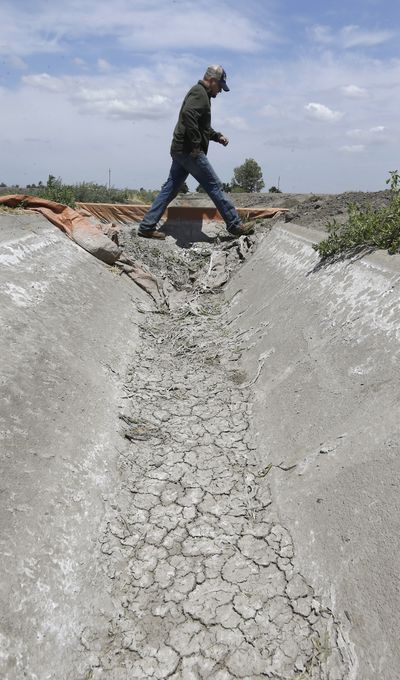California farmers reach agreement on water use
Voluntary reduction offered to head off looming mandate

LOS ANGELES – In a move reflecting the growing severity of California’s drought, state water regulators have accepted a historic proposal by Delta region farmers to voluntarily cut water usage by 25 percent, or, alternatively, to allow a quarter of their fields to lie idle.
The action follows a move by Gov. Jerry Brown to cut urban water use by 25 percent – an emergency measure that has caused no small amount of resentment among many residents who claim agriculture is not doing its share to conserve water.
Under an agreement with growers in the Sacramento-San Joaquin River Delta, the hub of the state’s water system, the state will allow farmers with some of the oldest and most secure water rights to voluntarily reduce usage by 25 percent.
“These are senior-water-rights holders stepping up to say they’ll do their part,” said Felicia Marcus, chairwoman of the State Water Resources Control Board, which announced the deal Friday.
The action applies only to so-called riparian rights holders, landowners whose property has direct access to a river or stream. By volunteering the cuts, delta farmers avoid the risk of being hit with even larger cutbacks mandated by state water regulators.
The delta region represents less than 10 percent of the state’s 6.9 billion acres of farmland, yet some see Friday’s action as a foreshadowing of new limits on agricultural water use statewide. Regulators have suggested such cuts are a near certainty, but they say cool, overcast weather, as well as recent rainfall, have allowed them to delay action.
The delta farmers’ proposal was particularly welcome as it seemed to remove the threat of lengthy and divisive litigation in a time of crisis.
The right of these growers to divert water directly from a stream or river dates back more than 100 years and has never before been challenged. However, as the state enters a fourth year of drought, water regulators say there is no way any one group can avoid water use restrictions.
“Curtailment of more senior water rights are virtually inevitable because there’s less water in the system than there are demands at even pretty senior-water-rights levels,” said Michael George, the state watermaster for the delta.
In the last month, the board has ordered about 9,000 so-called junior rights holders in the Sacramento and San Joaquin river basins to stop pumping from rivers and streams this summer. These junior rights holders have claims that date back only as far as 1914.
The board is also expected to impose cuts on some senior rights holders in the San Joaquin River watershed, who have claims that date back to before 1914.
The plan approved Friday was offered by growers and is one of a number of proposals the water board is considering.
“There’s lots of creative discussion going on; there’s also a lot of litigation swords being rattled,” George said. “It’s a trying time for everybody.”
Since the plan is voluntary, it remains unclear how many farmers will participate and what amount of water may be saved.
George Hartmann, a Stockton-based attorney who helped devise the plan on behalf of growers, said it could potentially save about 225,000 acre-feet of water if all eligible growers participate. However, water board officials said they weren’t about to make a prediction.
“It’s perilous to hazard a guess right now,” Marcus said.
Under the plan, growers must submit online applications to the water board by June 1, outlining how they will reduce water usage relative to their 2013 levels. If approved, the voluntary restrictions would remain in place through September.
George said there would be a number of ways the water board could verify compliance. If farmers chose the option of idling 25 percent of their land, satellite imagery would confirm this. Spot checks and peer pressure would, hopefully, ensure that farmers kept their promise to reduce water diversion.
The current drought is one of the most punishing in modern history. Irrigation deliveries have been slashed, forcing growers to idle more than 400,000 acres of cropland last year. Groundwater levels in some parts of the San Joaquin Valley have plunged to record lows as farmers drill more and deeper wells. Some small communities dependent on local sources have run out of water.
The levels of major reservoirs in Northern California are higher than they were a year ago. But the mountain snowpack that in a normal year provides the state with about a third of its water supply hit a record low April 1.